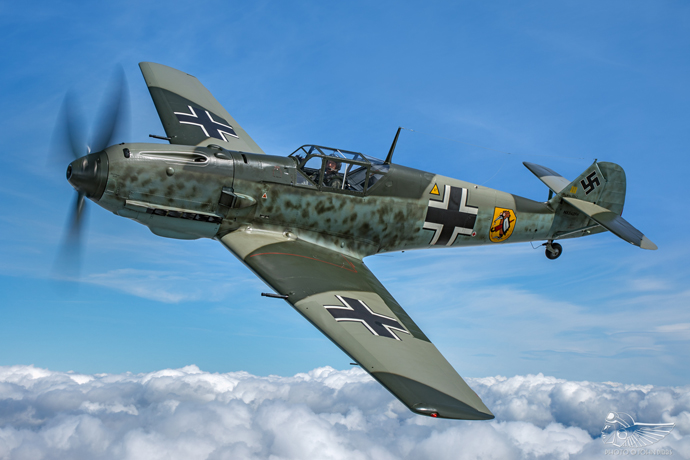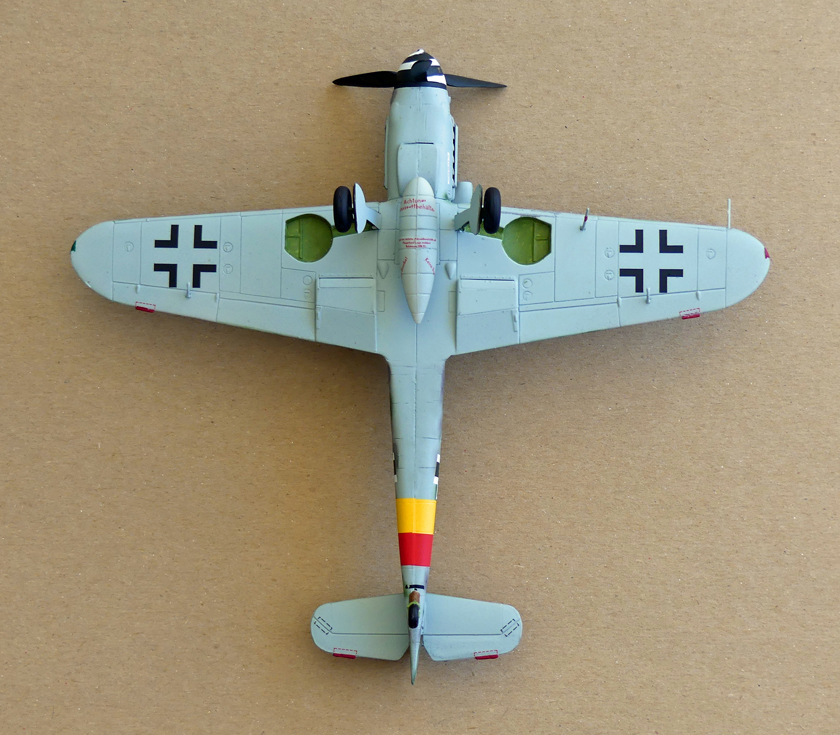

The Messerschmitt Bf 109 was the first true mass-production fighter and probably the most produced fighter aircraft in history, with almost 35,000 built in all. The G model (“Gustav”) had ten main variants and accounted for about 10,000 units produced. About 2,600 G-10 variants were produced.
The Bf 109 was designed by Willy Messerschmitt while working at Bayerische Flugzeugwerke, hence the designation “Bf”. In July 1938, the firm was reconstituted as Messerschmitt AG with Willy Messerschmitt as Chairman. After that, the fighter’s official designation was Me 109 although Bf 109 continued to be used as well. The first Bf 109 prototype flew in September 1935, ironically powered by a 695 hp British Rolls-Royce Kestrel engine, as German development of lightweight military aero-engines was prohibited under the Treaty of Versailles. However, a German engine was secretly developed side-by-side.
The Bf 109 first saw combat in 1937 during the Spanish Civil War and was extensively used by the Luftwaffe until the end of World War II. Initially designed as a fighter interceptor, its superior performance was demonstrated in public at the 1936 Berlin Olympic Games. The following year, the professional aviation world marveled as five Bf 109s participating in an international flying meet in Zurich exhibited outstanding speed, climbing, diving and maneuvering performance. On April 26, 1939, a specially modified version, the Me 209, set a new speed record of 469 mph (756 km/h), a record that remained unbroken until August 1969.
The Messerschmitt engineers kept their design simple, aiming to concentrate most loads in the firewall and minimize the number of separate parts in the aircraft. They decided to mount the most powerful engine they could on the lightest and smallest possible airframe and make the resulting aircraft easy to build and repair. And in this, they succeeded in great measure. Yet despite its lightweight construction, the Bf 109 was one of the most advanced fighters of the period on account of its all-metal monocoque construction, closed canopy and retractable landing gear. It was powered by a single Daimler-Benz DB 605A-1 liquid-cooled inverted V12, 1,455 hp aero-engine which gave it a maximum speed of 398 mph (640 km/h) and cruise speed of 367 mph (590 km/h). It was ultimately produced in over 100 variants for a variety of combat missions.
The Bf 109 was the backbone of the Luftwaffe’s fighter force and accounted for as much as 57% of all German fighter aircraft produced during the War. The all-time highest scoring fighter ace, Major Erich Hartmann, flew the Bf 109 and was credited with 352 aerial victories. In fact, this deadly fighter was the favorites of the three top-scoring German aces of World War II, who claimed 928 kills among them. It also held the record for the fighter that brought down the most Allied planes.
The Bf 109-E that entered production in 1938 was the standard Luftwaffe day fighter. Its two machine guns and two 20mm cannons gave it greater firepower than the RAF fighters. Apart from its limited fuel capacity, the main drawback of the Bf 109 was that it was very tricky to take-off and land. By some estimates as many as 10% of all Bf 109 losses were on account of takeoff and landing accidents. It was also outgunned by the Spitfire in the later stages of the War. Nevertheless, with the engineers constantly coming out with improved variants, the final Messerschmitt Bf 109 K had phenomenal climbing performance that its adversaries could not match. The Luftwaffe was defeated not by any technical inferiority, but because of lack of fuel supplies and being greatly outnumbered.
Although production of the Messerschmitt Bf 109 in Germany ended with World War II, it continued for some years after the war in Czechoslovakia and Spain. The Spanish Air Force actually used them until 1965. And the final twist in the epic Bf 109 tale happened when the Israelis, unable to acquire fighter aircraft from other sources, bought Bf 109s and used them in combat in 1948.
Facts and General Characteristics of the Messerschmitt Bf 109 G-10:
Contractor: Messerschmitt AG, Germany
Type: Fighter
Crew: 1
Wingspan: 32.5 feet (9.9 m)
Length: 29.5 feet (9.0 m)
Height: 8.6 feet (2.6 m)
Weight Empty: 5,880 lbs. (2,667 kg), Loaded: 7,496 lbs. (3,400 kg)
Powerplant: One Daimler-Benz DB605A-a rated at 1,475hp or DB605D rated at 1,800hp, driving a three-bladed propeller unit at the nose.
Max speed: 429 mph (690 km/h)
Rate of Climb: 3,300 feet/min (1,006 m/min)
Ceiling: 38,058 feet (11,600 m)
Range: 435 miles (700 km)
Standard Armament:
1 X 0.79 inch (20 mm) or 1.19 inch (30 mm) fixed cannon firing through the propeller hub
2 X 0.50 inch (12.7 mm) fixed forward-firing Rheinmetall-Borsig MG 17 machine guns in the upper part of the forward fuselage
External bomb load of 551 lbs. (250kg)
Facts and General Characteristics of the Model:
This model is a reproduction of a Messerschmitt Bf 109 G-10 with an auxiliary fuel tank and swept-forward radio antenna mast under the wing. Unlike many model manufacturers, no information was provided regarding the Jagdgeschwader (Wing), Gruppe (Group), Staffel (Squadron), home base, or operational dates designated by the paint scheme and marking colors. After researching the tail number of the model, it represents an aircraft flown by IV./JG301 possibly based in Stendal, Germany in spring 1945 as indicated by the “Defense of the Reich” yellow and red band toward the rear of the fuselage. The green horizontal bar indicates Gruppe II and the green “2” indicates the second plane in the Staffel. This plane did not have a unit emblem like most Luftwaffe fighters displayed.
Manufacturer: Revell GmbH, Germany
Scale: 1/48
Parts: 48
Decals: 72
Wingspan: 8.25"
Length: 7.5"
Height: Height: 2.0" (not including propeller blades)
Hours to build and paint: 21.5
Mistakes/problems:
1. This was my second try at using an airbrush for most of the model so there are a few painting mistakes.
2. The propeller spinner decal did not go on cleanly. I lost part of it and had to use white paint to fill in.
3. The “Auchtung” decal on the auxiliary fuel tank got slightly mutilated.
4. The instruction paint scheme called for a large section of bare metal under the fuselage and wings. I found this was historically accurate but didn’t like the way it looked and would have had to do one extra mask. So like Sinatra sang, “I did it my way” and used all one color like camouflage schemes on most allied and axis aircraft.






